#pronaos
Explore tagged Tumblr posts
Text
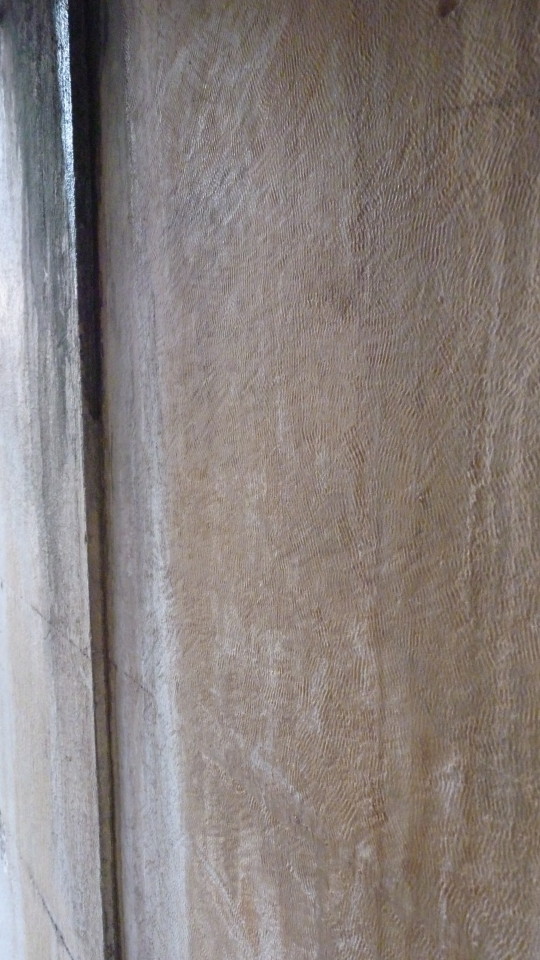
Today's Flickr photo with the most hits: chisel marks on the masonry walls of the corridor leading from the pronaos to the adyton, Temple of Apollo at Didyma.
3 notes
·
View notes
Link

0 notes
Text
Some Architecture Vocabulary

Arcade: a succession of arches supported on columns. An arcade can be free-standing covered passage or attached to a wall, as seen on the right.
Arch: the curved support of a building or doorway. The tops of the arches can be curved, semicircular, pointed, etc.
Architrave: the lowest part of the entablature that sits directly on the capitals (tops) of the columns.
Capital: the top portion of a column. In classical architecture, the architectural order is usually identified by design of the capital (Doric, Ionic, or Corinthian).
Classical: of or pertaining to Classicism.
Classicism: a preference or regard for the principles of Greek and Roman art and architecture. Common classicizing architecture is a sense of balance, proportion, and “ideal” beauty.
Column: an upright post, usually square, round, or rectangular. It can be used as a support or attached to a wall for decoration. In classical architecture, columns are composed of a capital, shaft, and a base (except in the Doric order).
Cornice: the rectangular band above the frieze, below the pediment.
Dome: a half-sphere curvature constructed on a circular base, as seen on the right.
Entablature: the upper portion of an order, it includes the architrave, frieze and cornice.
Frieze: the wide rectangular section on the entablature, above the architrave and below the cornice. In the Doric order, the frieze is often decorated with triglyphs (altering tablets of vertical groves) and the plain, rectangular bands spaced between the triglyphs (called metopes).
Metopes: the rectangular slabs that adorned the outside of Doric temples, just above the exterior colonnade.
Order: an ancient style of architecture. The classical orders are Doric, Ionic, or Corinthian. An order consists of a column, with a distinctive capital, supporting the entablature and pediment.
Pediment: a classical element that forms a triangular shape above the entablature. The pediment is often decorated with statues and its sides can be curved or straight.
Pronaos (pro-NAY-us): the entrance hall of a temple.
Triglyphs: a decorative element of a frieze consisting of three vertical units.
Vault: an arched ceiling usually made of wood or stone, as seen on the right.
Source ⚜ More: Word Lists ⚜ Notes ⚜ Writing Resources PDFs
#writeblr#writing notes#terminology#writers on tumblr#architecture#writing prompt#poetry#literature#poets on tumblr#spilled ink#creative writing#writing reference#dark academia#light academia#lit#worldbuilding#studyblr#langblr#booklr#bookblr#word list#writing resources
638 notes
·
View notes
Photo

Edfou (Apollonopolis Magna), Galerie Latérale de la Cour et Pronaos. 1851–52, printed 1853–54. Credit line: Purchase, Lila Acheson Wallace Gift, 1976 https://www.metmuseum.org/art/collection/search/261878
#aesthetic#art#abstract art#art museum#art history#The Metropolitan Museum of Art#museum#museum photography#museum aesthetic#dark academia
89 notes
·
View notes
Text

"The Temple of Dendera, known for the famous “Zodiac of Dendera” now housed in the Louvre Museum. Within the portico leading into the Hathor temple at Dendera is a little-known outstanding achievement of humanity: an extensive colored bas-relief—larger than the ceiling of the Sistine Chapel—meticulously encoded with the sophisticated astronomical knowledge of ancient Egypt. Drawing on more than 5,000 high-resolution photographs he has taken at the Temple of Dendera, photographer and computer scientist José María Barrera presents a complete full-color photographic reconstruction of the ceiling of the pronaos at Dendera and reveals in detail how each panel represents celestial cycles of time from the precession of the equinoxes to the annual cycles of life found along the Nile. He explains the meaning of the layout of the ceiling as it relates to the present, the past, eternity, the hours of the day, the phases of the moon, the constellations used in ancient Egyptian astronomy, the solar year, and the Great Year.
The author provides detailed analysis of each panel, including close-up photos, and explains each panel’s astronomical and spiritual significance from the ancient Egyptian perspective as well as examining the myths, gods, and goddesses depicted. He also includes an appendix exploring the meaning and symbology of ancient Egyptian iconography. Allowing you to experience the vivid details of this ancient work of art and science, this photographic exploration also re-creates the sense of spiritual awe and power the Temple of Dendera radiates to its visitors, whether today or millennia ago."
— Dendera, Temple of Time: The Celestial Wisdom of Ancient Egypt, by by José María Barrera
20 notes
·
View notes
Text

For día de muertos 2: "Know Thyself". The ancient Greek maxim "know thyself" or "gnothi seauton" (Greek: γνῶθι σεαυτόν), is one of the Delphic maxims and was inscribed in the pronaos (forecourt) of the Temple of Apollo at Delphi according to the Greek writer Pausanias (10.24.1). The aphorism came from Luxor in Ancient Egypt.
[Robert Scott Horton]
* * * *
You've heard that message from the source of whatever path you follow, very likely. This too shall pass. Even if it's hot in your heart at the moment, or gnawing at your brain like a fiery little animal. [candace] _____
It Passes Away What is the purpose of reacting to something when it is changing so quickly? What is the purpose of reacting with craving or clinging? It passes away. Or hatred: it passes away. —S.N. Goenka, "Superscience"
[alive on all channels]
#alive on all channels#S.N.Goenka#candace#Robert Scott Horton#Day of the Dead#dia de murertos#Know Thyself#all saints#all souls#Halloween#Ancient Egypt#temple of apollo at Delphi#Pausanias
10 notes
·
View notes
Text

2,600-Year-Old Temple Filled With ‘Exotic Offerings’ Found in Greece
In 2017, while exploring a sanctuary devoted to a goddess in Greece, archaeologists discovered the first traces of a monumental structure at the heart of the sanctuary.
Now, after years of excavations, the team has unearthed what has been identified as a temple filled with treasures, altars and “exotic offerings,” according to a Jan. 8 news release from the Swiss School of Archaeology in Greece, which oversaw the excavation with the help of the Ephorate of Antiquities in Euboea.
The temple was discovered “at the heart of the sanctuary of Artemis Amarysia,” researchers said. Artemis was the Greek goddess of wild animals as well as chastity and childbirth.
Archaeologists said the temple — which was built sometime toward the end of the seventh century B.C. — “held a number of surprises,” starting with is floor plan. The building was apsidal, meaning it had a semi-circular dome-like structure at one end.

This kind of floor plan, popularized during the Early Christian era between the fourth and eighth centuries A.D., was “quite unusual” for the time the temple was built, the team said.
The temple was “larger than originally anticipated,” measuring about 100 feet, according to experts. This measurement is symbolic, and several other monuments from the same period share the same dimensions.
Inside the structure, researchers found “another surprising discovery”: an abundance of hearths or altars.

Typical Greek sanctuaries of the time built these structure outside of the temple, but archaeologists said they found the stone platforms — covered with thick layers of ash and bones — within the building.
One altar, shaped like a horseshoe, appears to have occupied a pronaos — a vestibule surrounded by columns on the exterior of the temple — and has evidence that it was used as early as the end of the eighth century B.C., predating the temple, officials from Greece’s Ministry of Culture said in a Jan. 8 news release.
The team also discovered a rich collection of offerings, it said.

Among their finds were alabaster artifacts, vases, ritual water jugs, amulets, bronze and iron fittings, and precious jewelry made of gold, silver, coral and amber, officials said in their release.
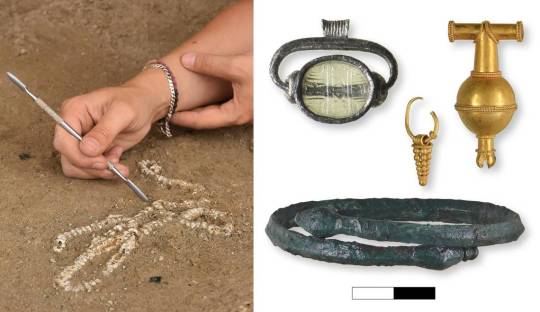

Experts also identified a “finely chiseled ivory head with Egyptian features,” they said. The “exotic” object was “unrecognizable” when first identified, but it has been restored.

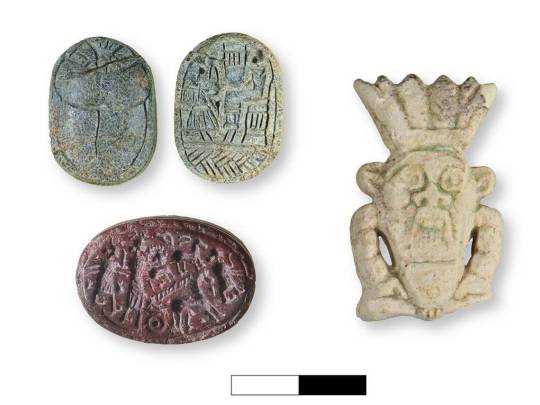
Evidence at the temple indicates that it partially burned down in the later half of the sixth century B.C., according to archaeologists. The building was temporarily restored with mud brick walls until it could be entirely replaced and restored at the end of the century.
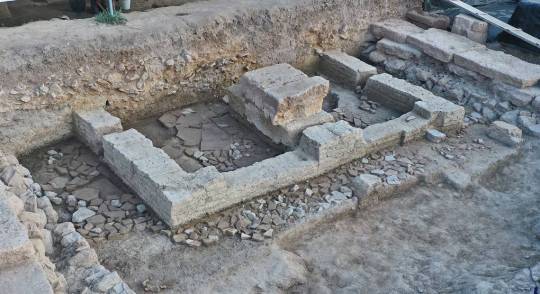
EVIDENCE OF AN EVEN EARLIER TEMPLE
Beneath the foundation of the temple, archaeologists said they discovered deep trenches containing remains from a building possibly dating to the ninth or eighth century B.C.

Bronze animal figurines from the same period and a terracotta bull’s head dating to the late Bronze Age — roughly 1200 B.C. — were also found in the trenches, according to researchers. Excavations of the lower levels of remains are ongoing, but early finds indicate that the site was used by Artemis worshipers earlier than the temple’s construction.
BRONZE AGE REMAINS NEARBY
The sanctuary of Artemis Amarysia is at the foot of a hill that was occupied during the Bronze Age, experts said.
Excavations of the hill have identified “imposing walls” that likely belonged to a third millenium B.C. fortification system, archaeologists said.
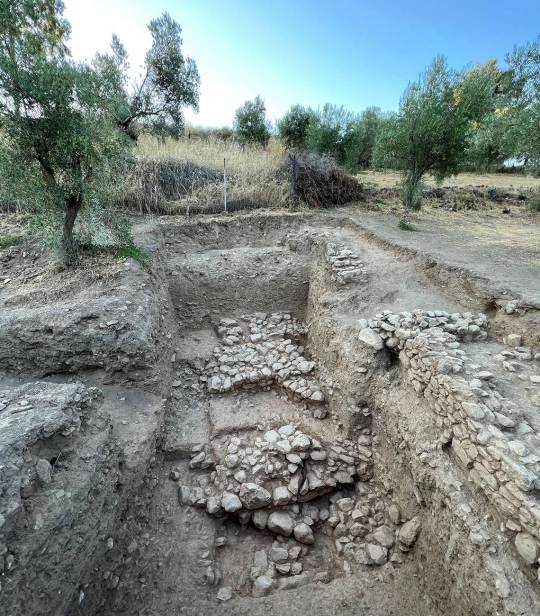
A tomb, filled with skeletons and offerings, was also unearthed from the hill, according to Greek officials.
Researchers continue to explore the region to determine how the temple and sanctuary fit into the broader “ancient landscape,” they said.
Amarynthos is on the Greek island Evia, also known as Euboea, which is off the country’s southwest coast.
By MOIRA RITTER.
#2600-Year-Old Temple Filled With ‘Exotic Offerings’ Found in Greece#he sanctuary of Artemis Amarysia#Greek island Evia#temple#ancient artifacts#archeology#archeolgst#history#history news#ancient history#ancient culture#ancient civilizations#Ancient Greece#greek history#greek art
41 notes
·
View notes
Text
In the pronaos of the temple are some ancient statues of the Charites, on the right the couch of Hera, and the dedication of a shield that Menelaos once took from Euphorbos at Troy. The great statue of Hera is seated on a throne of gold and ivory, the work of Polykleitos.Its crown has the Charites and Horai worked into it; in one hand she holds a scepter, in the other a pomegranate. As the story of the pomegranate is not to be spoken , I shall omit it. But they say a cuckoo sits on her sceptre because, when Zeus first loved the blossoming Hera, he changed into this bird and she hunted him for a pet.... They say that there stood beside Hera's statue one of Hebe, this too chryselephantine, a work of Naukydes. But on a column beside the (Polykleitean] statue is an ancient statue of Hera. This oldest of statues, made of pear wood and dedicated at Tiryns by Peiras son of Argos, was brought to the Heraion when the Argives captured Tiryns. I myself saw it there, a small seated figure. Interesting dedications include an altar into which the legendary marriage of Hebe and Heracles is worked and the emperor Hadrian's dedication of a peacock of gold and precious stones.
(Pausanias 2.17.46 Rocha-Pereira 1981).
- The Transformation of Hera: A Study of Ritual, Hero, and the Goddess in the lliad
Joan V. O'Brien
#hera#greek mythology#hera goddess#hera greek mythology#research#goddess hera#transformation of hera
18 notes
·
View notes
Text




A week ago, I went to visit the archeological area of Selinunte located in Sicily. Inside the area, on the Gaggera Hill there are the remains of a sanctuary of Demeter Malophoros.
The place has an ancient open-air altar located in front of the main temple. A canal carved in the rock is located between the altar and the temple carrying water to the sanctuary from a nearby spring. Just past the canal is the Temple of Demeter itself in the form of a megaron lacking a crepidoma or columns, but equipped with a pronaos, naos and adyton with a niche in the back. South of the propylaea, attached to the wall of the enclosure, was another enclosure dedicated to Hecate.
In the northern area there was another enclosure dedicated to Zeus Meilichios and Pasikrateia (Persephone). A very large number of finds came from the Sanctuary of the Malophoros: carved reliefs of mythological scenes, votive figurines in terracotta, large bust-shaped censers depicting Demeter and perhaps Tanit, Corinthian pottery, a bass-relief depicting the Rape of Persephone by Hades and the most ancient statue of Hecate ever found.
It was such a magical experience to visit this ancient and sacred place dedicated to the goddesses I am devoted to.
#paganism#hellenic polytheism#witchcraft#demeter and kore#hecate#selinunte#archaeology#pagan witch#greek temple#history#persephone#sacred places#my pics#sacred space#ancient greece#italianwitch#strega
8 notes
·
View notes
Text
Today I'm dwelling on the aftermath of the death of Argos, and the trial of Hermes with voting. I love the duality of there being anger in the action of throwing stones at him (replicating his actions that essentially lead to the death of Argos). That between the emotions of anger for some but to purify miasma at the same time for being listed as the first to commit murder among them.
Semi-related but I do love the addition of what most don't traditionally connect to Hermes but I do as someone who's spent 20+ years studying religions and older stories/media impacting culture:

Hermes and Athene will always be the two Hellenic deities connected to the eyes, to vision/sight, both in a literal sense and with foresight and the metaphorical (thought, application, and creativity).
Tldr Athene Pronoia, Hermes Syskopos, Athene Ophthalmitis, Hermes Euskopos, Athene Oxyderkês, Athene Pronaia & Hermes Pronaos my beloved
#dorian's polytheism diary#athena#athene#athene goddess#athena goddess#athena deity#athene deity#hermes#hermes god#hermes deity#hellenic polytheism#hellenic paganism#hellenic deities#hellenic worship#hellenic gods
17 notes
·
View notes
Text

Today's Flickr photo with the most hits: morning view of the Temple of Apollo at Didyma, Turkiye.
0 notes
Text

𝙷𝚎𝚕𝚕𝚘 𝚎𝚟𝚎𝚛𝚢𝚘𝚗𝚎!
I wanted to try and start a little series to provide information. It’ll include the greek gods as well as the saints. For the greek gods I want to try and do as many gods as I can before I get burnt out with this.
First I wanted to post about Lord Hermes. He’s been a part of my practice the longest and I feel the most connected to him. I really do hope that this post can be of use to anyone who needs. I certainly do hope that this post and this series can help me grow closer to my practice. So we will see!
𝙲𝚘𝚗𝚝𝚎𝚗𝚝𝚜
Who is Hermes?
Epithets
Family Tree
Symbols & Associations
Offerings & Devotions
Festivals
Sources
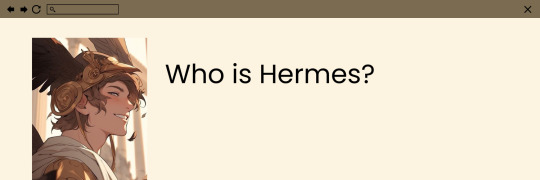
Hermes is the Olympian god of herds and flocks, travelers and hospitality, roads and trade, thievery and cunning, heralds and diplomacy, language and writing, athletic contests and gymnasiums, astronomy, and astrology. He is the messenger of Zeus as well as a guide of the souls, aka a psychopomp.
Greeks depicted Hermes as either a handsome and athletic, beardless youth or as an older, bearded man, with winged boots and a herald's wand. However, Hermes can appear to you in any way that fits. For me personally, he doesn’t completely fit the typical description, although I guess it does fit the handsome, athletic, beardless youth depiction.
Pop Culture
You may have seen Hermes around in your daily life. The caduceus is often used as a symbol in the medical world. Although not because Hermes is tied to medicine in any way. The use of the caduceus is simply due to many mistaking it for the rod of Asclepius. What’s the difference? Hermes’s staff depicts two snakes while Asclepius’s rod only depicts one.
Hermes himself appears in various pieces of media. Stories like Disney’s Hercules or Percy Jackson. He also appears in the Supergiant Games’s Hades as a god that can help you in your journey, or as a boss in God of War III.
You may have also heard of the luxury brand Hermès, which doesn’t seem to be related to the god at all but it pops up when you search him so I’m adding it anyway. I don’t actually know if this is a good brand or not but they seem to keep sustainability in mind so there’s that at least.
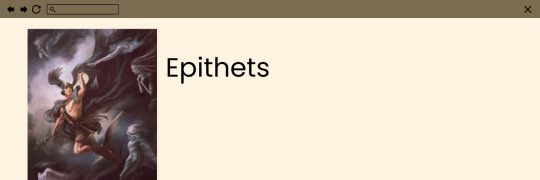
There are many different epithets for Hermes. While there isn’t as many as other gods, there’s still a decent amount of epithets for him. What are epithets? Well, they are essentially surnames for the gods to describe their different aspects. If you wish to call upon a specific aspect of a god you would use their epithet when talking with them.
Now for the different epithets of Hermes. I will be including the transliteration version of the names as the Greek names use special characters that I am unsure if they’ll even show up. So we’re getting close enough.
𝙲𝚞𝚕𝚝 𝙴𝚙𝚒𝚝𝚑𝚎𝚝𝚜
A
Aipytos
Of Aepytus (hero Arcadia)
Agoraios
Of the Market-Place
Akakêsios
Of Acacesium (Arcadia)
D
Dolios
Of Crafts, Of Wiles
E
Enagônios
Of the Games
Epimêlios
Keeper of the Flocks
H
Hermêneutês
Interpreter, Translator
K
Kriophoros
Ram-Bearer
Kyllênios
Of Mt Cyllene (Arcadia)
P
Promakhos
Champion
Pronaos
Of the Fore-Temple
Propylaios
Of the Gateway
T
Trikephalos
Three-Headed (Of Road-Intersections)
𝙿𝚘𝚎𝚝𝚒𝚌 𝙴𝚙𝚒𝚝𝚑𝚎𝚝𝚜
A
Akakêta
Guileless, Gracious
Aglaos
Splendid, Bright, Glorious
Angelos Athanatôn
Messenger of the Gods
Angelos Makarôn
Messenger of the Blessed
Athanatos Diaktoros
Immortal Guide
Argeiphontês
Slayer of Argos
Arkhos Phêlêteôn
Leader of Robbers, Thieves
B
Bouphonos
Slayer of Oxen
D
Dais Hetairos
Comrade of the Feast
Diaktoros
Guide, Messenger
Dôtor Eaôn
Giver of Good Things
E
Erikydês
Famous, Glorious, Splendid
Eriounês
Luck-Bringing, Ready-Helper
Euskopos
Keen-Sighted, Watchful
K
Kharidôtês
Giver of Joy
Kharmophrôn
Glad-Hearted, Heart-Delighting
Khrysorrhapis
Of the Golden Wand
Klepsiphrôn
Deceiver, Dissembler
Krateros
Strong, Mighty
Kratus
Strong, Mighty
Kydimos
Glorious
Kyllenios
Of Mt Cyllene
M
Maiados Huios
Son of Maia
Mastêrios
Of Searchers
Mêkhaniôtês
Trickster, Contriver
O
Oiopolos
Sheep-Tending, Shepherd
P
Phêlêtês
Thief, Robber, Rustler
Poikilomêtês
Full of Various Wiles
Polytropos
Wily, Many-Turning
Pompaios
The Guide
Poneomenos
Busy One
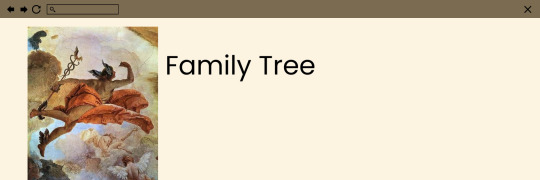
𝙿𝚊𝚛𝚎𝚗𝚝𝚜
FATHER ; Zeus - King of the Gods
MOTHER ; Maia - daughter of the Titanes Atlas and Pleione
𝙳𝚒𝚟𝚒𝚗𝚎 𝚂𝚒𝚋𝚕𝚒𝚗𝚐𝚜
Lady Artemis (half sister by Zeus)
Goddess of the Moon, the Hunt, Wild Animals & Wilderness, & Virginity
Lord Apollon (half brother by Zeus)
God of the Sun, Prophecy, Truth, Music & Poetry, Archery, Healing, & Light
Lord Ares (half brother by Zeus)
God of War
Lady Athena (half sister by Zeus)
Goddess of War, Wisdom, & Arts & Crafts
Lady Aphrodite (half sister by Zeus)
Goddess of Love, Beauty, Desire, & Fertility
Lord Hephaestus (half brother by Zeus)
God of Fire, the Forge, Metalworking & Sculpting, Craftsmen, & Technology
Lord Dionysus (half brother by Zeus)
God of Wine, Fertility, & Theatre
𝙳𝚒𝚟𝚒𝚗𝚎 𝙲𝚑𝚒𝚕𝚍𝚛𝚎𝚗
ANGELIA - goddess of messages Daughter of Hermes
ELEUSIS - goddess of the Eleusinian Mysteries. daughter of Hermes and Daeira
HERMAPHRODITOS (Hermaphroditus) - The hermaphroditic daimon son of Hermes and Aphrodite.
OREIADES (Oreads) Depends on the myth ; Many of the Oreiades were said to be the daughters of Hermes and other Oreaides Nymphai.
PALAISTRA (Palaestra) - goddess of wrestling Daughter of Hermes
PAN - the goat-footed god of shepherds son of Hermes and the Nymphe Penelopeia.
PANES Agreus ; son of Hermes and Nymphe Sose ; Nomios ; son of Hermes and Nymphe Penelopeia
PRIAPOS (Priapus) - god of garden fertility depends on the myth ; son of Hermes (most sources say this god was the son of Dionysus and Aphrodite).
SATYROI (Satyrs) Pherespondos, Lykos and Pronomos ; sons of Hermes and the Nymphe Iphthime
𝙼𝚘𝚛𝚝𝚊𝚕 𝙲𝚑𝚒𝚕𝚍𝚛𝚎𝚗
ABDEROS (Abderus) - prince of Opous who was loved by Herakles. son of Hermes
AITHALIDES (Aethalides) - A lord of Phthiotis who joined the expedition of the Argonauts. son of Hermes and Eupolemeia.
ARABOS (Arabus) - The first king of Arabia son of Hermes and Thronia.
AUTOLYKOS (Autolycus) - A thievish prince of Phokis son of Hermes and Khione.
BOUNOS (Bunus) - A king of Korinthos son of Hermes and Alkidameia.
DAPHNIS - A bard of Sikelia who invented pastoral or bucolic poetry son of Hermes and a Sikelian Nymphe
EKHION (Echion) - A lord of Alope in Malis who joined the expedition of the Argonauts son of Hermes and Antianeira.
ELEUSIS - A king and eponym of the town of Eleusis son of Hermes and Daeira
EUANDROS (Evander) - founded the city of Pallantium son of Hermes and the Naiad Karmentis.
EUDOROS (Eudorus) - A lord of Phthiotis son of Hermes and Polymele.
EURESTOS (Eurestus) son of Hermes and Aptale.
EURYTOS (Eurytus) - A lord of Alope in Malis who joined the expedition of the Argonauts. son of Hermes and Antianeira.
KAIKOS (Caecus) - A lord of Teuthrania son of Hermes and the Naias Nymphe Okyrrhoe.
KEPHALOS (Cephalus) - A lord and hunter of Attika son of Hermes and Herse (aka Kreusa)
KERYX (Ceryx) - A lord of Attika, first Herald of the Eleusinian Mysteries. son of Hermes and Agraulos (or Thrakian King Eumolpos)
KYDON (Cydon) - A lord of Kydonia in Krete son of Hermes and the Kretan princess Akalle
LIBYS A king of Libya son of Hermes and the princess Libya
MYRTILOS (Myrtilus) - The herald and charioteer of King Oinomaos of Pisa son of Hermes and Theoboula
NORAX - A prince of Iberia son of Hermes and Erytheia
ORION - A giant who was born in answer to the prayers of the childless Boiotian King Hyrieus son to Hermes, Poseidon and Zeus
PHARIS - A lord who founded the city of Pharai son of Hermes and the Danaid Phylodameia
PHAUNOS (Phaunus) - A barbaric Italian king who sacrificed strangers to his father ; slain by Herakles. Son of Hermes
POLYBOS (Polybus) - A king of Sikyonia son of Hermes and Queen Khthonophyle
SAON - The first king of the island of Samothrake son of Hermes and the Nymphe Rhene (OR Zeus and a Nymphe).
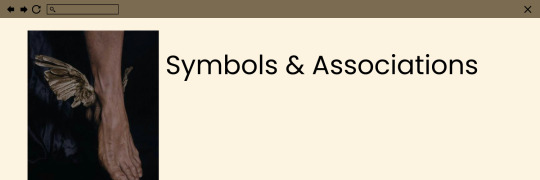
𝚂𝚢𝚖𝚋𝚘𝚕𝚜
Caduceus
Hermai (Stones that marked roads and boundaries, often with the carved head of Hermes)
Lyre
Petasos (Travellers’ Cap)
𝙰𝚗𝚒𝚖𝚊𝚕𝚜
Tortoise
Ram
Hawk
Rooster
Snake
Hare
𝙵𝚕𝚘𝚠𝚎𝚛𝚜, 𝚑𝚎𝚛𝚋𝚜, 𝚙𝚕𝚊𝚗𝚝𝚜, 𝚊𝚗𝚍 𝚏𝚛𝚞𝚒𝚝
Crocus
Greek Strawberry-Tree
Palm Tree
Almond Tree
𝙲𝚛𝚢𝚜𝚝𝚊𝚕𝚜/𝚂��𝚘𝚗𝚎𝚜
Amethyst
Hematite
Agate
Amber
Citrine
Peridot
Yellow topaz
Emerald
Red Marble
𝙲𝚘𝚕𝚘𝚛𝚜
Gold
Yellow
Orange
Silver
Grey
Green
Red
𝙴𝚕𝚎𝚖𝚎𝚗𝚝
Air
𝙿𝚕𝚊𝚗𝚎𝚝
Mercury
𝙳𝚊𝚢
Wednesday
𝚃𝚊𝚛𝚘𝚝 𝙲𝚊𝚛𝚍𝚜
Can really be any card that you decide to use as an identifier between you and Lord Hermes. These are just some suggestions.
Judgement
The Magician
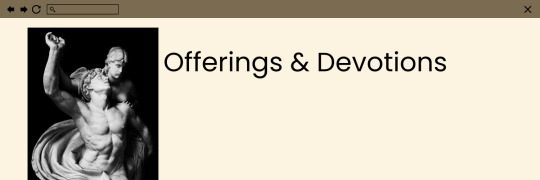
These are just suggestions! You can always find a different offering or devotional act based on your own personal associations and practice. And if you can’t provide any physical offerings, that’s okay. Devotional acts or digital offerings are just as good.
This list consists of UPG and SPG suggestions.
Offerings
Currency
Dice
Feathers
Travel Tickets
Souveniers
Imagry of his associations
Foods & Drinks
Foreign Foods
Red Wine
Olive Oil
Strawberries
Coffee/Energy drinks
Water
Honey
Lemons
Almonds
Cinnamon
Chocolate
Wheat
Devotional Acts
Travelling
Learn a new language
Play a sport
Learn Astrology
Practice public speaking
Do *harmless* pranks (Confuse, don’t abuse)
Write to him
Research
Donate to homeless shelters, to local sports teams, or relief charities
Workout
Make a devotional playlist and listen to it
Prayer to Hermes
I call to Hermes, son of thundering Zeus
and gracious Maia, fair of face and kind of heart;
father of Tyche, granter of serendipity.
In rugged Arcadia, land of your birth,
were you well known and praised by one and all; in all
the ancient world did you receive honors. Throughout
the land stood herms and mounded stones, at crossroads
and at boundaries, in all the far-flung provinces,
marking the path and holding your gift of fortune,
Far-journeying Hermes, guide of the traveler,
fleet-footed god of merchants, god of gamblers and thieves
and all who live by wit and wile and clever words,
master of discretion and finesse. Hermes,
protector of the home, provider of .feast and frolic,
courier of dreams, kind Hermes, I call to you.

Hermaea
The festival dedicated to Hermes celebrated in several parts of Greece. The boys were on this occasion dressed in their best, offered sacrifices to the god, and amused themselves with various games and sports.
𝚂𝚘𝚞𝚛𝚌𝚎𝚜
Theoi Summary
Theoi
Epithets
Timeless Myths
Study.com
Mythopedia
A Guide to Worship
Greek Gods Cheat Sheet
Prayers to Hermes
Hermaea
19 notes
·
View notes
Text
Temple - CC-free Community Lot

I made a ancient greek inspired temple community lot.

The temple has the three rooms. A closed Pronaos-like front. Then a cella/naos with the cult statue, and an adyton for the priests.
Download
6 notes
·
View notes
Text
4 dicembre, Santa Barbara

«Guardi, diceva un minatore muovendo in giro la mano tesa, tutto quello che lei vede è della Montecatini. Non si può sbagliare.» La Montecatini, qua a Niccioleta, possiede le case, le strade, gli spacci aziendali, i mezzi di trasporto, le sedi dei partiti politici, il terreno circostante. Della Montecatini sono i grossi casamenti gialli, sparsi in disordine per le pendici di questi colli scabri, collegati appena da un sentiero scosceso, con larghi improvvisi sterrati nudi; il palazzotto del dopolavoro, una costruzione pseudo - razionale, di taglio littorio, stile 900, come si diceva nel ventennio; e la chiesa, un altro scatolone con una specie di pronao rettangolare, che fa pensare ad una palestra di boxe. Son della Montecatini le grigie e scialbe casette degli impiegati, e la mediocre villa della contadina, ed i più vecchi amano ancora, dopo la miniera, coltivare un pezzetto di terra, per cavarne ortaggi, od allevarvi un coniglio, un paio di galline. Molti operai non abitano qui, ma nei villaggi vicini, a Prata, a Monterotondo, o vengono addirittura da Massa Marittima: tutti su automezzi della Montecatini; prima della guerra venivano in bicicletta, e non pochi a piedi, dieci chilometri di strada e dopo il lavoro.
L. Bianciardi, La lambretta dei minatori [1954]. Online QUI.
Immagine: Il pranzo del minatore, miniera di Niccioleta (GR), primi anni '70. Nel 'caldaino', conservato nella 'panierina', il primo e il secondo. E nella 'panierina' anche il vino, il pane, il sale, le posate… I topi, dove c'erano, riuscivano a penetrare nelle panierine (di cartone pressato) e allora se ne doveva usare una di lamiera zincata.
La foto, ovviamente 'in posa', da QUI.
11 notes
·
View notes
Text

Roma Curiosa: la Bocca della verità
🥰 in piazza Bocca della Verità si trova l’antico mascherone in marmo, uno dei simboli più celebri di Roma, collocato dal 1632 nel pronao della Basilica di Santa Maria in Cosmedin.
🟠Il grosso tondo, del diametro di circa 1.80 metri, era probabilmente un tombino di epoca romana, risalente al regno del 7°re di Roma Tarquinio il Superbo, che realizzò la Cloaca Maxima, un grandioso condotto per il drenaggio delle acque.
Questo sistema di canalizzazione partiva dalla Suburra, attraversava parte dell’attuale Rione Monti, del Foro, del Velabro e del Foro Boario, e sfociava nel Tevere, nei pressi di Ponte Emilio. La Cloaca Maxima era dotata di tombini in marmo, collocati l'uno vicino all'altro e decorati da bassorilievi.
Sicuramente uno di questi fu il celebre disco marmoreo: ha le fattezze di un volto maschile con barba, occhi, naso e bocca forati;rappresentava forse Giove, o un fauno o una divinità fluviale come Oceano, affiancato da alcuni simboli, tra cui uno scarabeo, due chele e due teste di lupo.
😇Il nome Bocca della Verità ha origine nel 1485 ed è legato a una leggenda medievale, secondo cui la bocca potesse mordere la mano di chi non avesse detto la verità.
😲Cosí i mariti gelosi conducevano lì le proprie spose e, dopo aver introdotto la mano, le donne dovevano dichiarare di non commesso adulterio.
❤️Il bellissimo film Vacanze Romane di William Wyler, con gli indimenticabili protagonisti Audrey Hepburn e Gregory Peck, ha consacrato la Bocca della Verità a una indiscussa fama: era il 1953 e da allora il leggendario mascherone è entrato nell’immaginario turistico mondiale.
2 notes
·
View notes
Text
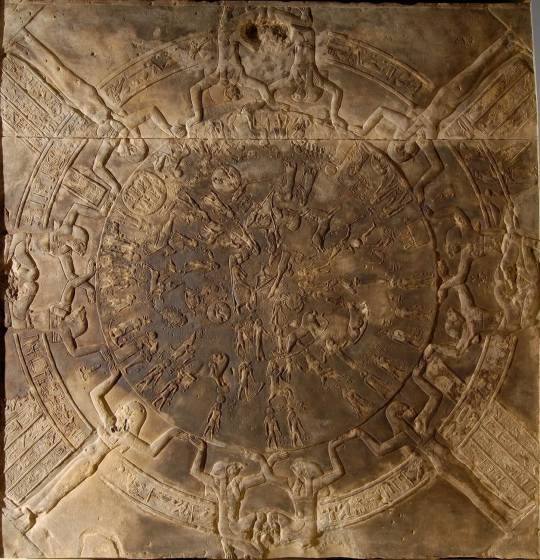
The Dendera Zodiac
The zodiac is a widely known Egyptian bas-relief from the ceiling of the pronaos of a chapel dedicated to Osiris in the Hathor temple at Dendera. It contains images of Taurus and the Libra.
The chapel was begun in the late Ptolemaic period; its pronaos was added by the emperor Tiberius. This led Jean-François Champollion to date the relief correctly to the Graeco-Roman Period. However, most of his contemporaries believed it to be of the New Kingdom.
The relief, which John H. Rogers characterized as “the only complete map that we have of an ancient sky”, has been conjectured to represent the basis on which later astronomy systems were based. It is now on display at the Louvre, Paris. D 38 ; E 13482 ; CM 464 Read more
124 notes
·
View notes